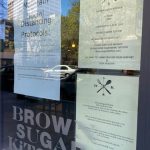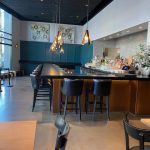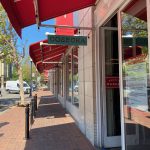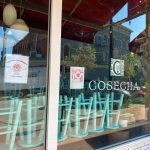This page was originally posted on Studio455 – Anthropology 455’s class site on May 12, 2020.
Introduction
In 2017, the Food and Accommodations Industries employed 88,386 people in San Francisco County and 66,350 people in Alameda County. Although these are not the largest numbers in the country, they certainly are quite substantial and highlight the importance of the food industry and its influence on Bay Area people’s lives. This project, which is still evolving and growing, explores the Bay Area’s tight-knit local restaurant community and how its relationships and culture have been affected by COVID-19 and the growing presence of technology. In addition, it attempts to confront the ideological representations of technology and how this juxtaposes the restaurant industry’s core values of hospitality and social relationships, as well as the multi-species representations of the food industry and how this has been challenged by the events going on around the world. In order to accomplish these goals, this page is split into different sections that try to interweave three different restaurateurs’ perspectives, the greater community’s relationship with technology, and an examination of the multi-species relationships that exist within the food supply chain. These different sections, or bites, are of course self selected but I hope that they can start conversations about the inevitable changes that are occurring at all different stages of the food industry.
Keeping the Soul Alive in Oakland
My first introduction to the Bay Area restaurant community was through Tanya Holland, chef and owner of Brown Sugar Kitchen. Brown Sugar Kitchen is an iconic soul food chicken and waffle establishment in Oakland. I had worked for Tanya the summer after my freshman year and she immediately connected me to a plethora of different owners, chefs, and community members. I met with her on April 7 at her empty restaurant. We sat two tables separated from each other but despite the distance and the strangeness of seeing the spacious seating area abandoned, her energy and optimism filled the room.
Below is a sound bite from our conversation.
“I think that people miss the human connection but I also think that it may have given some entrepreneurs and restauranteurs new thoughts about how to expand their product mix and offerings and supplement even the dine-in business.”
“It has been devastating. Oakland is a neighborhood community place. We can walk in any restaurant around here on any night of the week and will run into someone we know. That’s the beauty of Oakland. You know the owners even if you aren’t in the business.”
Less than a mile away…
Just a mere 0.9 miles a way from Brown Sugar Kitchen is Cosecha, another well-known local establishment serving local Mexican comfort food. While Tanya has decided to transition to limited in-store pickup, Dominica Rice, the founder and owner of Cosecha, has decided to keep her restaurant closed. Below is a sound bite from our conversation as she discusses the safety of delivery apps, her favorite eatery in SF, and her thoughts on the future.
“I saw one of the pizza bags, the plastic bags they keep things for Caviar that is shaped like a satchel… and it was in the middle of the floor as one of the drivers was in the bathroom.”
“Is that what we are going to be – just a parking lot of drivers? And there are no more neighbors coming out and we are not a part of their neighborhood? I don’t want to be a part of that.”
Fine dining, will it be fine?
“20 years ago if something was over salted you would just tell the server… now it’s like don’t say anything, wait until you get outside and get on your computer and write it.”
Cosecha and Brown Sugar Kitchen are both community establishments with local and chill atmospheres, but the Bay Area is also home to a prominent fine dining scene. The Bay Area is home to 59 Michelin-starred restaurants and many other fine dining establishments that offer pre-fixed tasting menu dining experiences. One of these restaurants is Nightbird, which ironically is situated only blocks away from both the Twitter and Uber HQs and whose clientele is heavily composed of these people in the technology industry. While Nightbird is currently closed to the public, Kim Alter, the chef and owner of Nightbird, has retained her staff and is working with organizations like Frontline Foods and the SF New Deal to deliver meals to essential workers. I had the opportunity to talk to Kim about how technology is actually positively contributing to pandemic relief efforts like Frontline Foods, the restaurants’ relationship with technology, and her outlook on the repercussions of COVID-19 on the industry.
“It is amazing how it has turned around and tech is stepping in and helping out by donating money to small business like mine to be able to cook for underprivileged and emergency workers. They are really doing good on two parts.”
Below is a visual bite from our conversation,
Is the Tech Delivering?
Tanya, Dominica, and Kim own just three out of thousands of restaurants in the Bay Area. While they all had different perspectives on reopening during the Shelter In Place orders, many other restaurants have taken their own unique approaches to staying in business. Below is an interactive map that displays the restaurants in the East Bay that are currently open. The map is segmented by color based on delivery app utilization and when a user clicks on the dot, a restaurant and its location, website, and delivery/pickup status are shown. Hopefully this map, which inherently is technological in nature and construction, can be a tool for users to not only see the divided perspectives on delivery app adoptance, but also a tool to help people reconnect with the restaurant community. I will admit that I was hesitant to use technology to represent this subject, but the map’s accessibility and usefulness outweighed my reservations as an ethnographer.
Although Tanya Dominica, and Kim did not turn to delivery apps before or after the COVID-19 outbreak, many other restaurants and customers have. The graph below shows the rise of the number of monthly views to the websites of the delivery apps DoorDash, Uber Eats, Grub Hub, and Caviar. From February to March, the DoorDash website experienced an increase of over 8 million views. Other apps also saw meteoric rises, as Uber Eats views increased by 5 million and GrubHub by over 4 million.
I decided to add Caviar, which is represented by the company’s characteristic orange color, because it was mentioned in many of the conversations I had with Bay Area restaurant community members. Caviar’s lower viewership numbers but its prevalence as an option for Bay Area restaurants can be attributed to the fact that it is a San Francisco/Bay Area-based startup. Its position as a Bay Area focused delivery app makes it unique compared to the other delivery companies, but also a perfect symbol for the turmoil that exists within the local community.
But what about the food in the takeout box?
While COVID-19 is changing how restaurant owners/chefs navigate their business operations and has influenced many on their choices regarding the utilization of technology, the pandemic has also dramatically affected the food that is being served in these takeout boxes. Tanya mentioned that she had to limit her menu because items like her signature light and airy cornmeal waffles do not travel well in takeout boxes. Not only are restaurants limiting their menus and therefore limiting their deliveries from producers, but with the closures of other restaurants, along with hotels and schools, some producers of vegetables, dairy, meat, and poultry are left with huge surpluses.
The news has been filled with stories about dumped milk, smashed eggs, plowed vegetables, and other foods going to waste. Each week, the chicken processor Sanderson Farms destroys 750,000 unhatched eggs, or 5.5 percent of its total production. The Dairy Farmers of America estimates that as many as 3.7 million gallons of milk are being dumped each day. In South Florida, which supplies to the Eastern half of the country, tractors are plowing perfectly ripe vegetables back into the soil. While farmers are scrambling to get rid of their unsold food, they are also learning about the consumption habits of the nation. According to a NYT article, “The Quarantines has shown just how many more vegetables Americans eat when meals are prepared for them in restaurants than when they have to cook for themselves.” I find this to be extremely interesting as it shows how the multi-species nature of our diet can be influenced by our choices to eat out at restaurants and ultimately by the decisions of the restaurant owners and chefs who operate these establishments.
“The Quarantines have shown just how many more vegetables Americans eat when meals are prepared for them in restaurants than when they have to cook for themselves.”
From these stories, it seems that food, despite its connection to multi-species relationships between humans, plants, and animals, has become a commodity. I find it incredulous that these plants and animals, which are as living and vibrant as we humans are, can be commodified to a point where they are destroyed because of lack of monetary value and not because of actual lack of demand. Although I personally was unable to fully observe or interview people working on this side of the food supply chain, it is clear that the pandemic is not only affecting people’s lives but also the animal and plant lives that we so heavily rely on to sustain ourselves.
“Each week, the chicken processor Sanderson Farms destroys 750,000 unhatched eggs, or 5.5 percent of its total production.”
Ultimately, not only are the restaurants and the people who work in them and the people who patronize them seeing drastic affects from this pandemic, but also the food supply chain and the other “species” that are involved. Although I set out to look at the way restaurants have been affected by the pandemic, the entire food process, not just the food consumption that happens at these restaurants, has been drastically changed. The food industry, which is multi-species in nature, is built on the relationships between farmers and plants; slaughterhouses and animals; and producers (these farmers and slaughterhouses) and consumers (restaurants and the person buying at the grocery store). The pandemic has shown how fragile the balance is between these relationships and how reliant the food industry is on these intertwining and multi-species connections.
Open for Business…
Reflecting on this project, I fear that I was unable to fully articulate the life-altering impacts of this current crisis on the restaurant community and how important these next months will be for these individuals and their businesses. In addition, while I was unsure about the multi-species aspects of this project, I was surprised to discover that the food supply chain is very interconnected and multi-species in nature. Although the food that people eat in restaurants is prepared and served with human hospitality and experience in mind, the ultimate production of this food depends on the relationships between humans, plants, and animals.
Moving forward, I am continuing this research over the summer to hopefully produce something that will better encompass and explore the intricacies of the Bay Area food community and its relationships, culture, and traditions. I hope to continue to work on my documentary and interview skills to make sure that small mistakes like the recording of the sound from my typing of notes in Dominica’s interview do not happen again. I plan on continuing to follow these owners and community members as they navigate the changing culinary and technology landscapes. From these initial conversations it is evident that these next months will be crucial for local businesses all over the Bay Area, as people begin to navigate re-openings and re-engaging with the community.
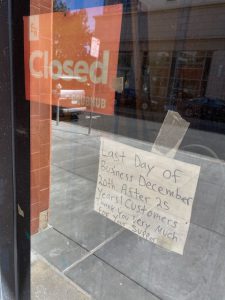
Honor Code: This site represents my work in accordance with University Regulations. – Skyler Liu
References:
Corkey, Michael and David Yaffe-Bellany. “Dumped Milk, Smashed Eggs, Plowed Vegetables: Food Waste of the Pandemic.” New York Times, 11 Apr. 2020. https://www.nytimes.com/2020/04/11/business/coronavirus-destroying-food.html.
